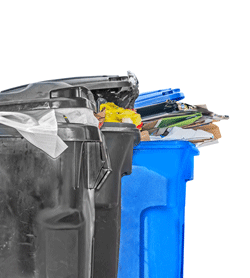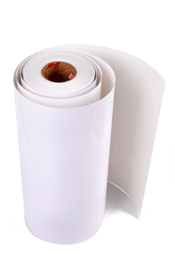Designing for Sustainability
 This article appeared in Issue 112 of InDesign Magazine.
This article appeared in Issue 112 of InDesign Magazine.Editor’s note: Our magazine articles are usually kept behind the paywall, and available only to subscribers. After all, subscriptions are what sustains CreativePro. But this article is different. It exists to inform designers about the environmental impact of their work and to inspire them to make sustainable choices whenever possible. We want it to be read by as many people as possible. So we’re making it freely available, both here on CreativePro and as a downloadable PDF. We hope you enjoy it, and please share it far and wide! If you’re not a subscriber, learn more about the benefits of membership and join us!
“When we try to pick out anything by itself, we find it hitched to everything else in the Universe.” —John Muir
The facts are clear, and not an exaggeration: The planet is facing an environmental crisis. Deforestation is removing natural filters for cleaner air while destabilizing the soil and destroying habitats for wildlife. Mining for industrial materials and energy sources is polluting the air, water, and soil. Expanding intensive agricultural operations are placing higher demands on freshwater availability. Waste runoff from factories and farms is contaminating waterways. And, of course, on top of all this, we are experiencing unprecedented levels of greenhouse gases accumulating in our atmosphere, driving new global climate patterns.
It’s a lot to process. The number and scope of these issues can make us feel as though it is impossible to make a difference. But print designers and publishers, more than ever, wield a unique power and position in the future of our environmental wellness. Whether we are proud of it or not, our work lasts long after it leaves our desk, long after it is packed by the printer, long after it is used and cast into a waste bin.
Our work lasts in several ways. There are the innumerable environmental domino consequences behind any physical item—for example, a sheet of paper may have been sourced from a tree felled by a gas-guzzling machine that, while puffing toxins into the air, eroded and compressed the soil as it dragged the timber away to be processed at a plant that discharges carcinogenic effluents into a stream. Much of the work we create ends up in landfills, or—one hopes—being recycled. And, of course, there are objects that are cherished, repurposed, or reused for years.
So our work as content creators matters, and—without question—every piece of it matters more to the world than we can ever know. But how did we arrive at this moment of such high environmental stakes, and what can we do about it?
How We Got Here
Long before the invention of modern media—e.g. the Internet, email, TV, radio, film, intercoms, telephones—there were two tools to communicate to the masses: a loud voice, or paper and pen. Unlike speech, paper offered a static record and could be distributed widely. To share an idea or a story beyond your immediate audience meant to create something physically transferrable, something durable enough to withstand handling while affordable enough to make in large quantities. And paper, of course, was a useful material, even beyond communication—for everything from building materials (as with Japanese shoji, room dividers of paper) to packaging (ranging from bags to boxes to wrappers).
 However, the earliest Chinese methods of papermaking—time-intensive processes highly reliant on manual labor, soon became suboptimal for the growing needs of rapidly expanding cultures. As early as the 11th century, papermaking began to involve large machinery like waterwheels that harnessed forces greater than manpower to drive faster production. Cloth rags of cotton, linen, and hemp were the common sources of paper fiber. Though cloth created a durable paper, it was expensive, and the means of attaining it were not scalable—rags were collected by “ragpickers” rummaging through the heaps of garbage left out on the streets (a primitive recycling system). By the Industrial Revolution of the 19th century, paper mills began primarily using wood pulp instead. It was far more efficient to turn a tree into clean paper than to harvest cloth scraps from the streets to clean and reprocess.
However, the earliest Chinese methods of papermaking—time-intensive processes highly reliant on manual labor, soon became suboptimal for the growing needs of rapidly expanding cultures. As early as the 11th century, papermaking began to involve large machinery like waterwheels that harnessed forces greater than manpower to drive faster production. Cloth rags of cotton, linen, and hemp were the common sources of paper fiber. Though cloth created a durable paper, it was expensive, and the means of attaining it were not scalable—rags were collected by “ragpickers” rummaging through the heaps of garbage left out on the streets (a primitive recycling system). By the Industrial Revolution of the 19th century, paper mills began primarily using wood pulp instead. It was far more efficient to turn a tree into clean paper than to harvest cloth scraps from the streets to clean and reprocess.
But turning to wood pulp had environmental costs, which were intricately involved with the cultural developments of the time. As forests were cleared and lumberyards were filled, landscapes—once the homes of diverse forest wildlife—were changed. Open land could instead be used to support expanding cities and new towns for people, or provide new sites to drill for oil or mine for coal. Paper mills sent away their goods via waterways, roads, and, eventually, air—all of which would participate in innumerable environmental consequences. Roads and highways fragmented the habitats of animals and plants, physically making migration, pollination, mate-finding, and food-foraging harder. Air travel contributed carbon dioxide emissions to the skies, and, like the other modes of transportation, added to noise pollution that would interfere with the sound-based communication of birds, insects, and other animals.
In any case, when wood pulp became predominantly used for papermaking, manufacturing became a booming industry. In England and Wales alone, paper mills increased from fewer than 25 in 1810 to more than 400 in 1969, and paper production increased from less than a hundred thousand tons in 1800 to more than 4.5 million tons by 1965.1, 2 Over time, cities that weren’t able to compete with industrial manufacturing operations would supply other pieces to the process, such as trees, machinery, or chemicals. The global industry of paper was born.
The Environmental Footprint of Papermaking
 Of course, logging and transportation are only one part of the environmental impact of making paper products. The paper industry is estimated to contribute as high as seven percent of the world’s annual greenhouse gas emissions, higher than those from aviation.3 Paper and pulp mills are considered to be the sixth largest source of pollution in the world, and they emit a diverse range of pollutants, from liquid effluents to gases, particulate matter, and solid wastes.4
Of course, logging and transportation are only one part of the environmental impact of making paper products. The paper industry is estimated to contribute as high as seven percent of the world’s annual greenhouse gas emissions, higher than those from aviation.3 Paper and pulp mills are considered to be the sixth largest source of pollution in the world, and they emit a diverse range of pollutants, from liquid effluents to gases, particulate matter, and solid wastes.4
Just consider the hot broth of liquid chemicals it takes to break down tough, woody fibers and bleach them to achieve the bright white paper we love so much. For instance, upon leaving the paper mill facility, effluents change sodium, chlorine, and nitrogen levels in the soil,5 which can disrupt seed germination or growth patterns of plants, which can affect the animals that consume them (and which might already be directly affected by the chemicals dumped into the local water). There has been extensive documentation of animals and plants being harmed by paper mill effluents around the world, from tree swallows6 to mayflies,7 barnacles,8 algae,9 and numerous species of fish.10–12
Problems by Design
Think about these product and packaging designs: Business cards printed on plastic. Gift tags made of metal. Shrink-wrapped candy boxes containing shrink-wrapped boxes within shrink-wrapped boxes. Book sleeves made of solid wood.
 Excessive designs may be eye-catching and beautiful. Yet, they are extravagant uses of natural resources. Even if they do not imply a self-centeredness about the special importance of the product, they betray an ignorance of a design’s role in the environment (which ultimately reveals another form of self-centeredness). Ephemera produced with materials that can last centuries will provide one complex answer to future anthropologists and ecologists about how we landed in this environmental crisis—a simple lack of consideration and foresight, a matter of sheer hubris.
Excessive designs may be eye-catching and beautiful. Yet, they are extravagant uses of natural resources. Even if they do not imply a self-centeredness about the special importance of the product, they betray an ignorance of a design’s role in the environment (which ultimately reveals another form of self-centeredness). Ephemera produced with materials that can last centuries will provide one complex answer to future anthropologists and ecologists about how we landed in this environmental crisis—a simple lack of consideration and foresight, a matter of sheer hubris.
But not all unsustainably produced items are for glamour’s sake. Some products are designed not to last, which can be just as environmentally problematic. Textbooks, for instance, have long been manufactured with “planned obsolescence”—the books are purposely designed not to last, so that students cannot share (and privately sell) used copies amongst themselves forever. This is partly to boost book sales, but also is based on the need for keeping textbook content up-to-date. The glue, binding, and paper of textbooks are notoriously of poor quality for these reasons, despite their high cover price. Meanwhile, as stressed college students strip down their dorms and empty their backpacks at the end of an academic term, these books may end up in landfills (rather than recycling bins), where they will decompose, slowly emitting methane, an atmospheric greenhouse gas considered at least four times more powerful than carbon dioxide.
The Promise of Greener Paper
Historically, attempts to improve the ecological sustainability of the paper industry have focused on rates of timber harvesting, types of trees harvested, and general pollution reduction.13 But these issues ignore perhaps the biggest problem with the paper industry: its heavy reliance on wood for paper pulp. However, there’s no rule that paper needs to be made from wood!
Using non-wood sources of paper pulp instead of woody sources can significantly reduce the environmental impacts of our current paper industry. Not only can other plants grow and replenish much faster than trees, non-woody material has softer fiber than wood. This means it can be cooked down with chemicals that leave the processing facility as soil-fertilizing effluents and irrigation water, reducing deforestation and providing a profitable opportunity for farmers hoping to reduce agricultural waste.14 Non-woody plants such as wheat (Triticum spp.), cotton (Gossypium spp.), sunflower (Helianthus spp.), industrial hemp (Cannabis sativa L.), and vines (e.g., Vitis spp.) can all be used to make paper.14 Bamboo, the world’s fastest growing plant, can produce six times as much pulp for paper as a conventional pine forest can.3
 Non-plant materials can also be used to create specialty papers, such as Ellie Pooh’s papers, which contain 30 percent fiber from elephant poop.15 In another radical example, Cradle to Cradle: Rethinking the Way We Make Things is a book made of plastic; the book is designed to withstand intensive sharing with others and can ultimately be recycled with your yogurt cups.16
Non-plant materials can also be used to create specialty papers, such as Ellie Pooh’s papers, which contain 30 percent fiber from elephant poop.15 In another radical example, Cradle to Cradle: Rethinking the Way We Make Things is a book made of plastic; the book is designed to withstand intensive sharing with others and can ultimately be recycled with your yogurt cups.16
Even when it comes to wood-based paper, some manufacturing methods are far better than others. Paper made from virgin fiber is unquestionably less sustainable than recycled paper:
- Virgin-fiber paper generates an average of 10.67 tons of greenhouse gases per ton of paper, more than three times the amount produced by recycled paper.
- Virgin-fiber paper requires four times the amount of water needed to produce than recycled paper.
- And virgin-fiber paper takes 50 to 80 percent more energy to be created.3
According to Joel Lueb, President at Bigger Dot, a print project and management company,17 “Most paper companies that are selling paper in Europe and North America don’t have a choice but to offer more responsibly manufactured papers. The market is demanding not just greener options but greener standards.”
Note, however, that not all recycled papers are created equal. Within recycled papers, there are differences in environmental footprint, importantly determined by the amount of post-consumer fiber content in the paper. Recycling processes and energy sources can also vary between processing plants—the amount of recycled fiber may be the same, but the environmental footprint may differ substantially. The paper company Rolland, for instance, uses biogas energy, and the recycled papers it produces generate significantly less waste, water, and carbon emissions than other types of recycled paper of comparable recycled fiber content. The Rolland Eco Calculator allows consumers to compare Rolland products against virgin and recycled products made by other companies.18
Along with Rolland, other leading companies in environmentally friendlier papers include Sappi (you can read their environmental fact sheets here), Mohawk Papers,19 and Finch Paper.20
Even so, it’s only fair to point out that all types of recycled papers have environmental impacts of their own. In order to attain brightness and smoothness, recycled papers require bleaching and processing, which takes up energy and generates effluents.
Inks, Bindings, and More
Though we tend to focus most on paper when considering the environmental impact of printing, it’s worth taking a moment to consider other aspects of print design, too. Inks, varnishes, glues, printers, binding, and packaging elements like grommets, cords, zippers, and buttons are all items that print designers may work with—and each comes with its own environmental footprint.
Major developments have been made with ink, with numerous “eco-friendly” options based on water or vegetable oils, and with lower emissions of harmful volatile chemical compounds.
On the other hand, when it comes to desktop printers, these inks require cartridges that are typically made with plastic and have a substantial environmental cost in their manufacturing and disposal. One toner cartridge can result in 4.8 kilograms of carbon dioxide emitted in its manufacturing and can take over a thousand years to break down in a landfill21—and an estimated 374 million cartridges are thrown out every year.22 Some printers are more energy efficient than others; for instance, the HP PageWide family of multifunction printers can use up to 84 percent less energy than similar laser printers.23
Binding materials also vary widely, with metal and plastic types requiring more energy to manufacture and degrade than thread stitching or glue. Most glues used today are water-based, which makes them more biodegradable. The same logic applies to packaging elements, with metal and plastic accents having greater environmental consequences than those made with more easily degraded materials.
The reality is that there isn’t a perfect solution—every material item carries an environmental impact. But it’s worth considering all the options when thinking about your project.
Paperless Isn’t Always Greener
It may surprise you to learn that sometimes print is more environmentally responsible than digital. After all, computers and smartphones require energy to be powered, create complex waste disposal problems that cross international borders, and involve extremely energy-intensive servers and data centers to connect. A 2018 article on Co.Design even reports that purchasing a new smartphone model can consume as much energy as using an older model for ten years. According to the United Nations Environment Programme, roughly 40 million tons of e-waste is generated every year. And the water footprint to manufacture a single smartphone is estimated at 3,190 gallons.
 When might print be greener than digital?
When might print be greener than digital?
- When something is occasionally referenced but in rapidly repeated, short bursts of time. As any smartphone owner knows, repeatedly turning on and off a machine can sap energy. Whether it is notes for a presentation or a lengthy around-town shopping list, sometimes a slip of paper is lighter on the environment than repeatedly powering a device on and off.
- When something is a long-term, static display. A large screen advertising a one-time event months ahead may require far more energy to be powered continuously than a equally large poster. Similarly, a decorative wall of screens or projections installed for long-term use may require more energy to maintain than an attractive paint job, wall decals, or wallpaper.
- When you process information slowly and across a long time. Especially for slow readers, wading through a long, difficult PDF or e-book might use up more energy than consuming the copy in print. It’s also known that people digest information differently in print and digital forms—if you find yourself unable to retain information as well digitally, you may find yourself referencing it more often, again using more natural resources to power up your device.
- When something may be treasured for sentimental value. Whether you’re powering on your computer constantly to revisit a photo of your favorite pet or draft (and re-draft) a long, passionate love letter to your sweetheart, your environmental impact might be less if you order a photo print to keep around, or write the letter on paper…especially if you hope the note will be kept and read over and over again. (As a bonus, it’s certainly more romantic.)
You can read more on the environmental impacts of print vs. digital publishing here, here, and here.
Making Green Decisions
With so many potential pitfalls, what can an environmentally responsible designer do? Don’t give up! Here are several recommendations to consider.
Question convention
The most important thing a designer can do for the planet begins well before InDesign loads up. It starts with asking strategy-level questions. Why do we want this thing to be made? What is it for? (Okay, yes, but what is it REALLY for?) What are other ways to achieve these goals?
For example, a university may request a designer to create a print catalog of all its course offerings to help students select courses. After some probing, an environmentally sensitive designer might find that most students never reference their print catalog and enroll in courses entirely online. With some research on how students select courses, perhaps an effective and more environmentally sustainable solution is to design a more seamless website or app, rather than a hefty book filled with content that expires by the next semester.
Or, perhaps a nonprofit wants its in-house team to design a pair of large vinyl banners to hang in front of their building, announcing a new fundraising event. After more intensive inquiry, though, an environmentally sensitive designer might discover that the directors really want to reach dog owners, and the building is isolated from where most dog owners live. A set of smaller signs posted strategically in dog parks and near pet supply stores might be more effective than the large banners, which, being made of thick vinyl, do not readily decompose in landfills.
Ultimately, clear, strategic thinking that begins at the outset of a project will have a bigger environmental impact than quick fixes tacked on at the end.
Personalize
Mass-mailing is rarely as effective as personalized content, and generally not as environmentally responsible. Instead of shouting to the masses, focus your time on creating for people who are eager and willing to hear from you. It may be worth researching who those people are.24 A smaller, customized production run delivered to the right people can be far more effective for your marketing than a massive, spammy effort. A little effort here can help you reach the same number of people (or more!) while cutting back on environmental demands.
Simplify, simplify, simplify
 While those of us working in design and production roles rarely have the power to make large-scale editorial decisions, seize the opportunity if it presents itself, because concision demands fewer materials. Try to persuade others to simplify the message and cut words to reduce page counts or paper size. Even if the paper quantity or dimensions cannot be altered, you’ll use less ink.
While those of us working in design and production roles rarely have the power to make large-scale editorial decisions, seize the opportunity if it presents itself, because concision demands fewer materials. Try to persuade others to simplify the message and cut words to reduce page counts or paper size. Even if the paper quantity or dimensions cannot be altered, you’ll use less ink.
Reusable packaging
Packaging serves several functions: to contain the product, to explain the product, and to convey the brand. But it’s often the most ephemeral component of a product and discarded before long. This makes packaging traditionally one of the more environmentally damaging items to produce.
Fortunately, with some “thinking outside of the box,” it’s possible to design far more environmentally sustainable packaging. A sleeve for a spring-themed gift card could be made of a recycled paper beautifully embedded with wildflower seeds (ready to be planted and visited by bees), as Starbucks has done. A plastic bag could have suggestions printed on it for fun ways to reuse it (from lunch bag to water balloon), as Target did in recent years. A tub of yogurt might offer suggestions for reuse on its label or lid, as Nancy’s Yogurt has done. A box for fragile macarons could be a redesigned as a tube, requiring less paper.
Consider every item first
Before designing, think through every material item needed to execute your plan. Then, whether you are working on small-scale runs out of your local office printshop or larger runs with a print materials supplier and distributor, ask the customer service representative for help in selecting more environmentally friendly materials, and do your own research. Stewart Jordan, Senior Account Executive at Westland Printers,25 says that the resources are available for those who seek them: “I think designers need to tap industry resources and ‘green’ focused designers to learn more about how to incorporate sustainability in their design.”
Create Responsibly
 I love print and the beautiful, lasting, tactile designs that can be printed. But it’s important to remember that while we design, edit, and create at our desks, we are, in effect, making a multitude of decisions that shape the way our work will affect the world at large. As creators, every one of our decisions counts. And no matter what we do, we are making a decision with a consequence for the world around us and generations ahead. Creating work we can be proud of isn’t merely about the content or design. It’s also about the ethical implications of what and how we are creating. It’s about recognizing our individual and collective impact in choosing for outcomes that we may never witness directly.
I love print and the beautiful, lasting, tactile designs that can be printed. But it’s important to remember that while we design, edit, and create at our desks, we are, in effect, making a multitude of decisions that shape the way our work will affect the world at large. As creators, every one of our decisions counts. And no matter what we do, we are making a decision with a consequence for the world around us and generations ahead. Creating work we can be proud of isn’t merely about the content or design. It’s also about the ethical implications of what and how we are creating. It’s about recognizing our individual and collective impact in choosing for outcomes that we may never witness directly.
We are all responsible for the environmental crises around us, though some of us might not be seeing them in our backyards—yet. As our growing global population presses the planet for more resources, the communicative role (and responsibility) of designers and publishers has never been more important. When we create, we lead. We can choose to do so responsibly and ethically, and feel proud for doing so. Because we will be designing a difference that matters to the planet.
Works Cited
1. Shorter, A.H. 1971. Paper Making in the British Isles: A Historical and Geographical Study. David & Charles Limited. Newton Abbot, UK.
2. Howard, N. 2005. The Book: The Life Story of a Technology. Greenwood Press. Westport, CT.
3. Hawken, P., editor 2017. Drawdown: The Most Comprehensive Plan Ever Proposed to Reverse Global Warming. Penguin Books. New York City, NY.
4. Ali, M. & Sreekrishnan, T.R. 2001. Aquatic toxicity from pulp and paper mill effluents: a review. Advances in Environmental Research 5, 175–196.
5. Hansen, E.A., Dawson, D.H., Toldsted, D.N. 1980. Irrigation of intensively cultured plantations with paper mill effluent. Tappi 63(11):139–43.
6. Harris, M.L. & Elliott, J.E. 2000. Reproductive success and chlorinated hydrocarbon contamination in tree swallows (Tachycineta bicolor) nesting along rivers receiving pulp and paper mill effluent discharges. Environmental Pollution 110(2):307–20.
7. Lowell, R.B., Cult, J.M., Wrona, F.J. 1995. Stimulation of increased short-term growth and development of mayflies by pulp mill effluent. Environmental Toxicology and Chemistry 14(9):1529–41.
8. Wu, R.S.S. & Levings, C.D. 1980. Mortality, growth, and fecundity of transplanted mussel and barnacle populations near a pulp mill outfall. Marine Pollution Bulletin 11:11–15.
9. Rosemarin, A., Lehtinen, K-J., Notini, M., Mattsson, J. 1994. Effects of pulp mill chlorate on Baltic Sea algae. Environmental Pollution 85:3–13.
10. Kovacs, T.G., Gibbons, J.S., Tremblay, L.A., O’Connor, B.I., Martel, P.H., Voss, R.H. 1995. The effects of a secondary-treated bleached kraft mill effluent on aquatic organisms as assessed by short-term and long-term laboratory tests. Ecotoxicology and Environmental Safety 31:7–22.
11. McMaster, M.E., Van der Kraak, G.J., Portt, C.B., Munkittrick, K.R., Sibley, P.K., Smith, I.R., Dixon, D.G. 1991. Changes in hepatic mixed function oxygenase (MFO) activity, plasma steroid levels and age at maturity of a white sucker (Catostomos commersoni) population exposed to bleached kraft pulp mill effluent. Aquatic Toxicology 21:199–218.
12. Munkittrick, K.R., McMaster, M.E., Portt, C.B, Van Der Kraak, G.J., Smith, I.R., Dixon, D.G. 1992. Changes in maturity, plasma sex steroid levels, hepatic mixed-function oxygenase activity, and the presence of external lesion in lake whitefish (Coregous clupeaformis) exposed to bleached kraft mill effluent. Canadian Journal of Fisheries and Aquatic Sciences 49(8):1560–1569.
13. Pogue, T.E. 2008. A sectoral [sic] analysis of wood, paper and pulp industries in South Africa. Sector Studies Research Project. Institute for Economic Research on Innovation. Electronic document. https://www.labour.gov.za/downloads/documents/research-documents/Wood,%20paper,%20pulpsa.pdf
14. Xiao, C. 2005. Black liquor from crop straw pulping as a potassium source and soil amendment. PhD Dissertation. Department of Crop and Soil Sciences. Washington State University. Electronic document. https://www.dissertations.wsu.edu/
Dissertations/Spring2005/c_xiao_042605.pdf
15. Mr. Ellie Pooh. 2018. Our Paper. Web address: https://mrelliepooh.com/pages/our-paper Accessed 9 May 2018.
16. McDonough, W. & Braungart, M. 2002. Cradle to Cradle: Rethinking the Way We Make Things. North Point Press. New York.
17. Bigger Dot. 2018. https://www.biggerdot.com Accessed 9 May 2018.
18.?Rolland Eco Calculator. 2018. Eco Calculator. https://www.rollandinc.com/en/environmental-stewardship/eco-calculator Accessed 6 May 2018.
19. Mohawk Papers. 2018. Sustainability. https://www.mohawkconnects.com/about-us#paragraph-4 Accessed 9 May 2018.
20. Finch Paper. 2018. Environmental Stewardship. https://www.finchpaper.com/environmental-stewardship/ Accessed
9 May 2018.
21. Preton, Ltd. 2010. Environmental issues associated with ink and toner usage. Electronic document. https://www.preton.com/pdf/pretonsaver_envi_whitepaperfinal_1403010.pdf
22. Gorman, B. 2017. Ink Waste: The Environmental Impact of Printer Cartridges. https://www.theenergycollective.com/bobbyg/2401395/ink-waste-environmental-impact-printer-cartridges Accessed 7 May 2018.
23. HP PageWide. 2016. The Carbon Footprint of Your Tech Equipment. https://www.computerworld.com/article/3133624/it-management/the-carbon-footprint-of-your-tech-equipment.html Accessed 9 May 2018.
24. Osterwalder A. & Y. Pigneur. 2014. Value Proposition Design: How to Create Products and Services Customers Want. John Wiley & Sons. Hoboken, NJ.
25. Westland Printers. 2018. https://www.westlandprinters.com/ Accessed 9 May 2018.
[else_memb_has_any_tag]. . . .
This article is for members only. To continue reading, please sign in, or sign up for a membership today. Thanks for supporting CreativePro! CreativePro membership keeps you up-to-date with the technology, solutions, and resources to strengthen your professional development.
BECOME A MEMBER
For just $6.50/month (billed annually), you’ll get access to valuable benefits, including:
[/memb_has_any_tag]






One solution would to publish more books like my two-volume Oxford English Dictionary. You need a magnifying glass to read the blasted thing. Of course, a solution that draconian would undoubtedly help the sale of ebooks.
And if you’re talking about wasted paper, among the worst offenders are law firms. When I moved cross-country a few years back, I needed lots of boxes. A friend who works as a paralegal supplied me with—I kid you not—dozens of the large boxes that hold copy paper. Law firms consume paper by the truckload.